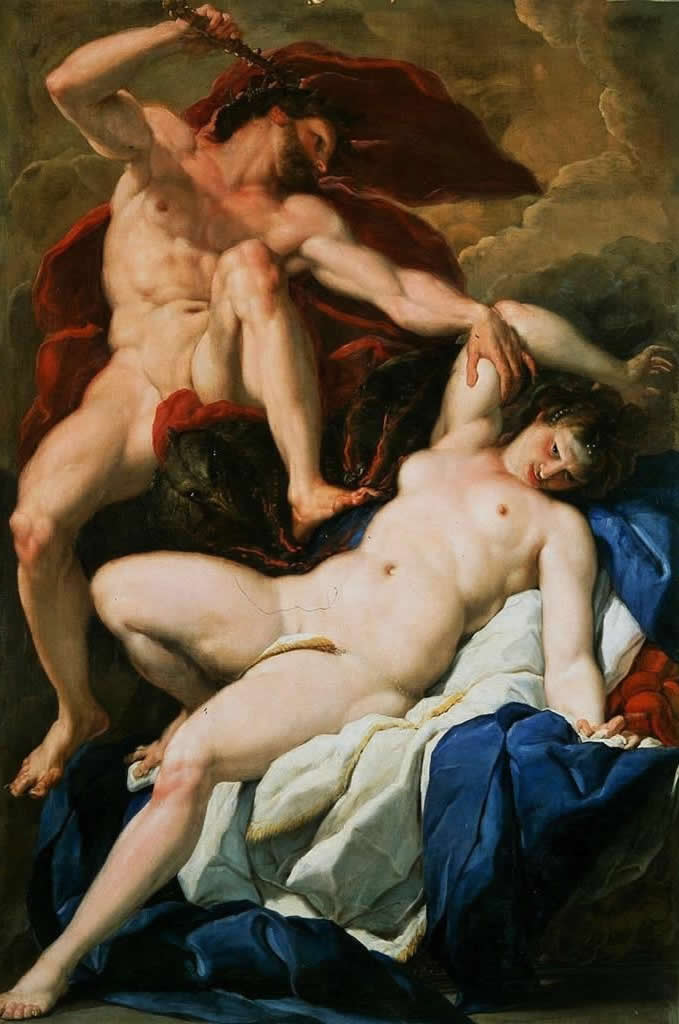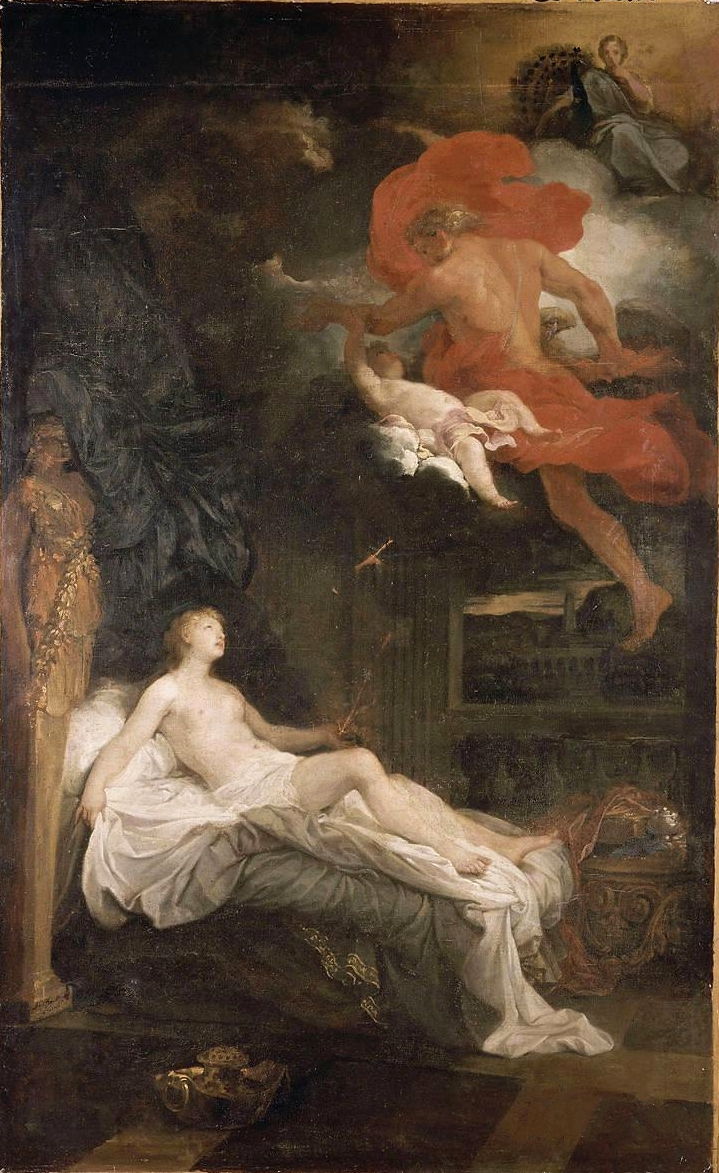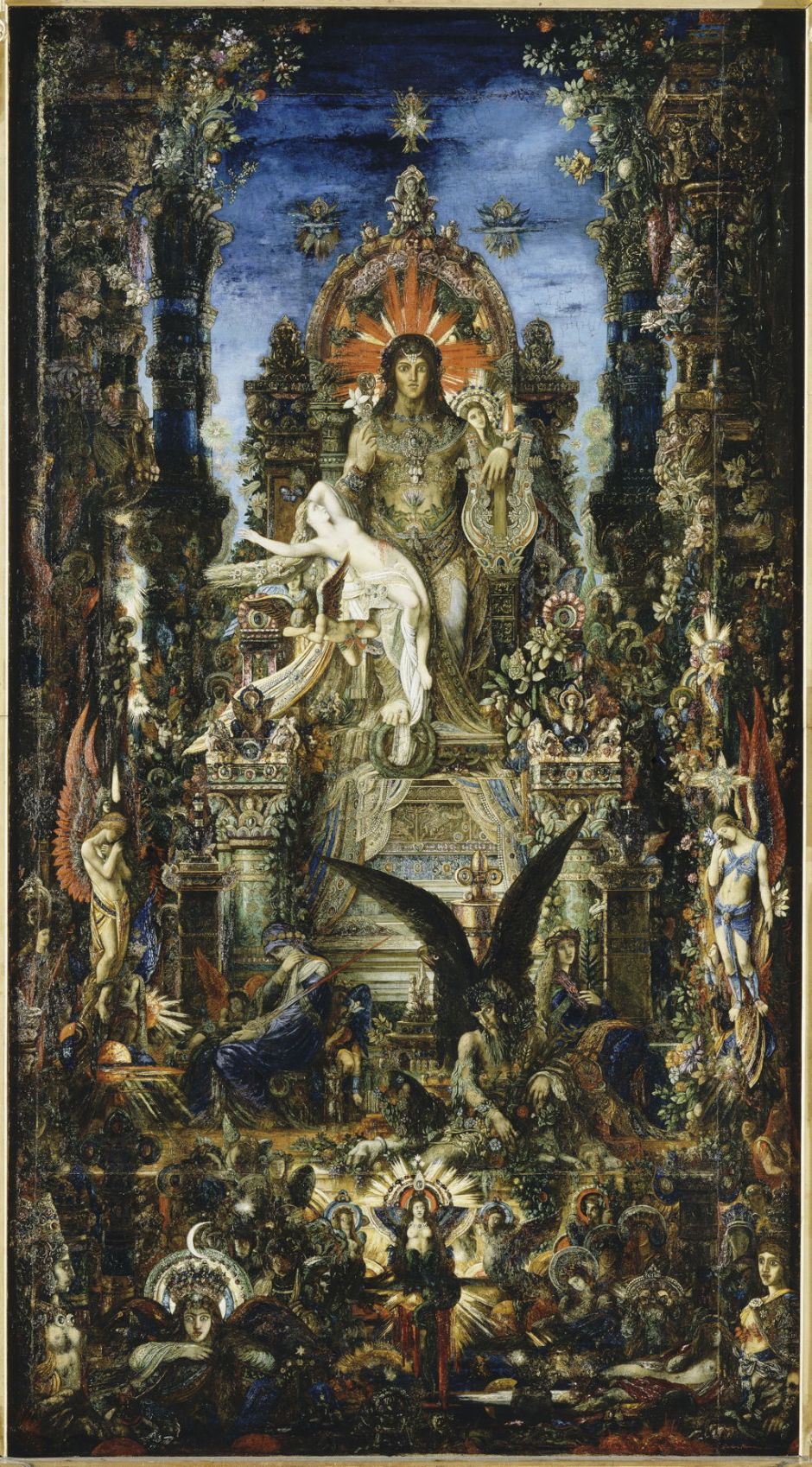Following the story of Actaeon’s tragic death while out hunting, Ovid continues his short summary of the myths of the Theban cycle with that of Semele, daughter of Cadmus the founder of the city of Thebes. Of all the strange tales in his Metamorphoses, this must be the weirdest of the lot, as it involves caesarian section and surrogate pregnancy.
Perhaps inevitably, the father of Semele’s unborn child is Jupiter, although Ovid doesn’t mention how their relationship originated. The vindictive Juno decides she’s going to ‘deal with’ Semele in retribution, so disguises herself as Semele’s old nurse and sows doubt in her mind about her lover’s true identity. The goddess advises Semele to ask Jupiter to reveal himself in his full divine glory, knowing that this will bring about the mortal woman’s destruction.
When Semele puts this to Jupiter, he realises that this would put Semele at grave risk: being the god of the sky and thunderstorms, she would almost certainly be killed by his thunderbolts. But she is insistent, driving him to gather his weakest thunderbolts and smallest storms, then to reveal himself to her. Unfortunately, Semele is immediately consumed in flames from Jupiter’s lighting, and dies.
Jupiter then seizes her unborn baby from inside her body, and continues the pregnancy by sewing the foetus into his thigh. When the baby is eventually born, he becomes Bacchus, who later rescues Semele from the underworld, and has her installed as a goddess on Mount Olympus.

This painting of Jupiter and Semele from 1545, attributed to Jacopo Tintoretto, shows the god approaching his lover, who looks remarkably relaxed at the prospect of his thunderbolts.

Sebastiano Ricci’s Jupiter and Semele of 1695 also shows Semele resting on a couch, this time facing Jupiter with her back to the viewer. The god has revealed himself in an impressively cloudy and stormy setting, and holds an arrow-like thunderbolt in his right hand. In the foreground is his eagle, and a cowering Cupid who looks anxious. Although smoke is emerging from a pot, there are no signs of Semele being in danger.

Tintoretto’s earlier Jupiter Appearing to Semele (1541-42) is one of his series depicting stories from the Metamorphoses. The god is impressive, clutching thunderbolts in both hands, with his eagle flying below. Semele is shown with extreme foreshortening, and isn’t yet being consumed by fire.

Dosso Dossi’s Jupiter and Semele, from about 1525, is one of the earliest paintings of this myth. The couple are seen among the clouds, he naked apart from a red cloth covering his left leg, she fully clothed. He holds a thunderbolt in his right hand, above Semele’s head, but there are no signs of her bursting into flames. There’s also an interesting collection of objects at the lower right, including what appears to be a small tortoise, as a sign of love and fertility, perhaps. There’s also a set of keys, and a bag tied at its neck.

Paolo Pagani’s Jupiter and Semele from about 1700 still seems removed from imminent danger. She lies back displaying her body to the viewer, with no signs of pregnancy, and a strange grimace. Jupiter has arrived in the midst of thunderclouds, holding a thunderbolt in his right hand, and Semele’s right arm with his left hand. Flames are licking around his left foot, which is perilously close to Semele. Under Jupiter is his large black eagle.

In Luca Ferrari’s Jupiter and Semele from about 1640, Jupiter appears to be borne on his eagle, and his lover shields her face with her right hand, as she’s already starting to have second thoughts about the wisdom of her challenge to the god.

Peter Paul Rubens’ oil sketch of The Death of Semele from about 1620 reveals Semele in more obvious distress, and pregnant, on a bed. Jupiter grasps his thunderbolt in his right hand, as a dragon-like eagle swoops in through the window.

Pietro della Vecchia closes in for a close-cropped view in his Jupiter and Semele of about 1640, although Semele’s pregnancy isn’t revealed, and there’s no sign of any eagle. By this moment, Semele has realised what the thunderbolts behind Jupiter’s back are going to do to her.

Bon Boullogne’s Semele, painted at the end of the seventeenth century, is one of the few paintings to give a close account of the climax. Semele lies on a bed beside a herm, her left hand starting to burn after being struck by a small thunderbolt. Above her, Jupiter is making off with a large infant – not just full-term but older – while Juno, identified by her accompanying peacock, is in the distance at the top right.
The next artist to attempt a painting of Ovid’s narrative was Gustave Moreau, two centuries later.

Moreau worked out the composition of the central section of his second and more ambitious painting in this earlier Jupiter and Semele, made during 1889-95. Semele hasn’t yet been harmed by thunderbolts, but the foetal Bacchus appears to be resting against her, and Jupiter has assumed his divine form. At the foot of the painting is the god’s eagle.

That composition then formed the centrepiece of his large finished painting, also titled Jupiter and Semele, from 1895. Jupiter now sits on a massive throne, with Semele draped over his right thigh. Surrounding the couple is one of the most iconographically rich canvases in the history of art, a dense confluence from many cultures across Europe, North Africa, the Middle East, even into India.

At its heart, Jupiter rests his left forearm on Apollo’s lyre. His right hand holds a lotus flower, and he looks straight ahead with his eyes wide open. Behind his left shoulder is the image of a female deity, perhaps Juno’s watchful and avenging eye.
Semele is statuesque, her arms cast back in shock. Her left side is covered in blood, presumably from where the foetus has been extracted, although in this painting no foetus is visible. Her hair flows off in a long, thick tress, decorated like a peacock’s feathers, reflecting her transient displacement of Juno from being Jupiter’s consort. She shows no signs of catching fire yet. Below her is a winged Cupid, its face buried in its forearms, grieving at Semele’s imminent doom.
This is a difficult story to paint true to Ovid’s words, and trying to depict them literally could only cause incredulity. As Moreau’s last great mythical painting, he has surely succeeded better than anyone before.

